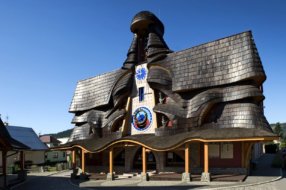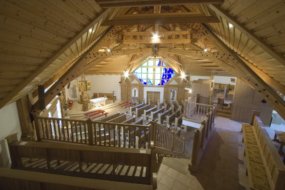Culture & History
One of the main reasons to visit the Malá Fatra region is its rich history and culture. There is not one place that doesn’t have at least a short historical story attached to it. The gateway to the region – the town of Žilina – is rightly recognised as being worth a visit. But did you know that the national premiere of the first ever film dramatizing the life of Jánošík took place in Žilina? There is an exhibition on the life of Slovakia’s most famous outlaw in the village of Terchová.
If you travel to Kysuce, don’t forget to visit the only Slovak astronomical clock at Stará Bystrica, which is the most accurate in the world. The towns and villages of the region also have a rich cultural life. Every year, nearly everyone looks forward to the legendary Jánošíkove dni (Jánošík Days) festival in Terchová, the Staromestské dni (Old Town Days) in Žilina or the interesting events that bring to life Strečno Castle, the open-air museum at Vychylovka and Budatín Castle.
The historic centre of Žilina
Historic buildings, many cosy cafés and restaurants, the small shops lining one of the longest pedestrian zones in Slovakia – this is Žilina town centre. When strolling around the town, take time to enjoy the Andrej Hlinka Square and the Mariánske Square, which has been declared a Town Conservation Reservation. This has the largest density of historic buildings reflecting the history of the town. Stop and spend some time in each of them.
Andrej Hlinka Square
Once upon a time, the River Váh flowed through this space but the townspeople redirected it and replaced it with fields. Later it was tiled over and became a square where eight roads meet. In the past, the brook Všivák flowed through the square but it has been covered over too.
Church of the Most Holy Trinity (cathedral church)
This appears on nearly every postcard of Žilina and it has become the town’s unofficial symbol. If you miss the Holy Trinity church, you might as well not have been in Žilina. It began as a Gothic church but after reconstruction it now shows mainly a Renaissance style. The free-standing bell tower known as Burian’s Tower offers a beautiful bird’-eye view of the town centre.
Our tip: Take a photo of the Church of the Most Holy Trinity from Hlinka Square and take home a souvenir with the most characteristic view of the centre of Žilina.

The Slovak astronomical clock in Stará Bystrica
Why go outside Slovakia? Did you know that you can admire an astronomical clock in our country? The Kysuce village of Stará Bystrica offers a treasure, the likes of which cannot be found anywhere else in the world. It holds several records such as being the most accurate astronomical clock in the world and the only one in Slovakia.
The largest wooden sculpture
The overall composition of the astronomical clock was inspired by a seated figure of the Blessed Virgin Mary of the Seven Sorrows, one of Slovakia’s patron saints. It is shaped from wooden tiles held in place by an 80-piece timber framework.
Pribina with a sword
In alcoves around the astronomical clock there are six bronze busts. Can you name any of these famous Slovaks? Visitors are under the eyes of Prince Pribina, King Svätopluk, Anton Bernolák, Ľudovít Štúr, Milan Rastislav Štefánik and Andrej Hlinka. It is interesting that Pribina is shown with a sword and Svätopluk appears with a crown as the king of the early Slovaks. All six busts were cast in bronze.
The heart of the astronomical clock
The most significant part of an astronomical clock is the astrolabe, a means of displaying astronomical information. It is the astrolabe that gives Stará Bystrica the first and only astronomical clock in Slovakia. Without it, it would just be an ordinary clock. The colours of the main panel of the astrolabe represent the stages of the daily cycle: black for night, red for sunrise, light blue for the day and red again for sunset. A hand with the sun moves around these fields based on the current location of the sun. The main panel of the astrolabe is further divided by golden edging indicating the Equator, Tropic of Cancer, Tropic of Capricorn and the local meridian, which is the segment of the line showing when the sun reaches the highest point in the sky over Stará Bystrica
Gallery and information centre
There are two bells in the astronomical clock’s turret. One bell tolls the hours while the other provides an accompaniment to the mechanical promenade of the apostles. In the room under the astronomical clock there is an art information centre. It has a small gallery that sells the work of professional and amateur artists.
Our tip: Wait for the astronomical clock to chime the hour. Observe with bated breath as the apostles go by to the sound of the bells while an audio commentary tells the story of the Slovak astronomical clock. We are sure that you will remember this experience for a long time, and you may want to wait another hour to see the show again.

The Church of St. Andrej Svorad and St. Benadik in Radôstka
Radôstka is a picturesque village in a beautiful setting in the Kysuce Highlands. However, what people most often photograph here is not the beautiful landscape. It is the Roman Catholic Church of St. Andrej Svorad and St. Benadik. Visit Radôstka during your holiday in the Malá Fatra region and we can guarantee that you will also want a photograph of it.
A small village with a big award
Not every village in Slovakia can boast that they have an award-winning church. Radôstka has one, and they are rightfully proud of their church. The European Institute of Cultural Routes, based in Luxembourg, awarded the design of the interior of the Church of St. Andrej Svorad and St. Benadik second place for rural architecture in eastern Europe. This should make it clear why the church gets photographed so often.
Modern but traditional at the same time
The church is made of wood. It appears modern but it preserves traditional Kysuce building techniques and fits beautifully into the mountainous landscape. The overall design of the building and the natural materials used are in harmony with the characteristics of the region. The wood for the construction of the church was donated by local residents. A tall belfry and a rectory are attached to the church. Unlike other recently built churches, this building shows real sensitivity in its use of stone and wood. The interior incorporating elements of folk architecture is certainly worth a visit. Hearing mass in this magnificent space is an outstanding experience.